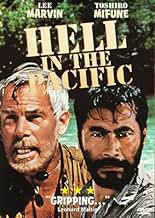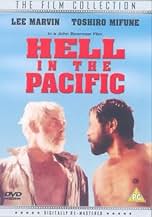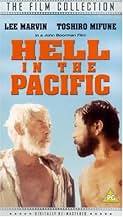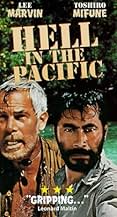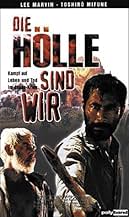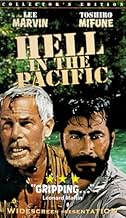Agrega una trama en tu idiomaDuring World War II, an American pilot and a marooned Japanese navy captain are deserted on a small uninhabited island in the Pacific Ocean. There, they must cease their hostility and cooper... Leer todoDuring World War II, an American pilot and a marooned Japanese navy captain are deserted on a small uninhabited island in the Pacific Ocean. There, they must cease their hostility and cooperate if they want to survive, but will they?During World War II, an American pilot and a marooned Japanese navy captain are deserted on a small uninhabited island in the Pacific Ocean. There, they must cease their hostility and cooperate if they want to survive, but will they?
- Dirección
- Guionistas
- Elenco
- Premios
- 1 premio ganado y 2 nominaciones en total
- Captain Tsuruhiko Kuroda
- (as Toshiro Mifune)
Opiniones destacadas
This is not Cast Away Meets WWII. For one thing, it has a much tighter focus, completely losing anything beyond the island's horizon. It is admirable in its bloody-minded focus, and, with only two actors to cast, it's hard to imagine how it could have been any more perfect that pitching wild-man extraordinaire Lee Marvin opposite Kurosawa favorite Toshiro Mifune. A genius idea, but one that could have failed with a more conventional approach.
We are introduced to both antagonists in a neutral way, free to prefer which ever one we choose, though that is hardly the point, and director John Boorman makes it both easy and at times hard to sympathise with either in equal measure. Both actors do a fine job, playing mostly emotional and physical roles with great restrain and intelligence.
Boorman's direction is perfect, rejecting excess stylization in favor of a subtle approach, aided by superb photography. You have got to see this at least once, simply because, for all its visceral thrills, it is quite profound without ever trying to be. Because it boasts top performances from two of the last century's greatest leading presences in action cinema. Because, though frustrating at first, the ending is, for once, the smartest one that could have been chosen. Humanity is on trial and the judges choose to be honest and pragmatic, thus delivering something that combines greatness and very thoughtful substance.
We need more films like this!
This is a rare work of film that uses two actors, limited dialog(half of it in Japanese), and only one location. There have been many attempts at making movies about people stranded on islands, but this one pulls it off in a way no other has.
Thsi is a film about not only survival, but overcoming prejudice towards ones sworn enemy in a time of war. It is about moving past the fears of what you do not know, and using what you do know and the basic need to survive to pull through and band together.
I was more enthralled by this movie with almost no dialog, than I have been with movies that have won screenplay Oscars. To me, this is an example that if you have the right actors, the right story, and the right setting, dialog is not always necessary.
Straightforward and gripping movie with magnificent acting by only two protagonists ,the dynamics Marvin and Mifune , fighting all by themselves , as playing American and Japanese soldiers coming to terms with each other on an uninhabited island in the Pacific Ocean, both of them stranded together . However , the movie sometimes lapses into tedium and slowness , though contains striking images with moments of great power and wonderful scenarios . It's one of the sharpest and cleverest war film of the 60s masterfully and stylishly realized. The handsome cinematography by Conrad L. Hall does full justice to the varied settings on the Pacific ocean , bursting into the colour . Imaginative and haunting score by Lalo Schifrin.
The motion picture is well directed by John Boorman . He's a real professional filmmaking from the 6os, though sparsely scattered and giving classics as ¨Point Blank¨ . His film are without exception among the most exciting visually in the modern cinema as he proved in ¨Deliverance¨ , ¨Excalibur¨,the best of them, , a rare Sci-Fi titled ¨Zardoz¨ , ¨Emerald forest¨ with a ecologist denounce included and of course ¨Hell in Pacific¨.
¿Sabías que…?
- TriviaBoth Lee Marvin and Toshirô Mifune actually served in the Pacific during World War II, of course on opposing sides. Marvin was a US Marine. He was wounded during the war and received the Purple Heart during the Battle of Saipan in 1944. Mifune served in the Imperial Japanese Army Air Service.
- ErroresLee Marvin was 44 at the time of filming, as evident by his gray hair. Toshiro Mifune's character also calls him an "old man" several times. WWII US Navy pilots Thus, he looks much too old for an actual WWII US Navy pilot, who were mostly in their twenties or early thirties.
- Citas
American Pilot: Oh, for a second I thought you were a Jap.
- Versiones alternativasAmerican version featured an alternative ending where the two get drunk and walk off in separate directions arguing at each other; in the British version (which was exactly the same as the Japanese version), they start yelling and a bomb from the sky falls and blows everything apart.
- ConexionesFeatured in Hollywood Remembers Lee Marvin (2000)
Selecciones populares
- How long is Hell in the Pacific?Con tecnología de Alexa
Detalles
Taquilla
- Presupuesto
- USD 4,150,000 (estimado)
- Tiempo de ejecución1 hora 43 minutos
- Relación de aspecto
- 2.35 : 1
Contribuir a esta página



